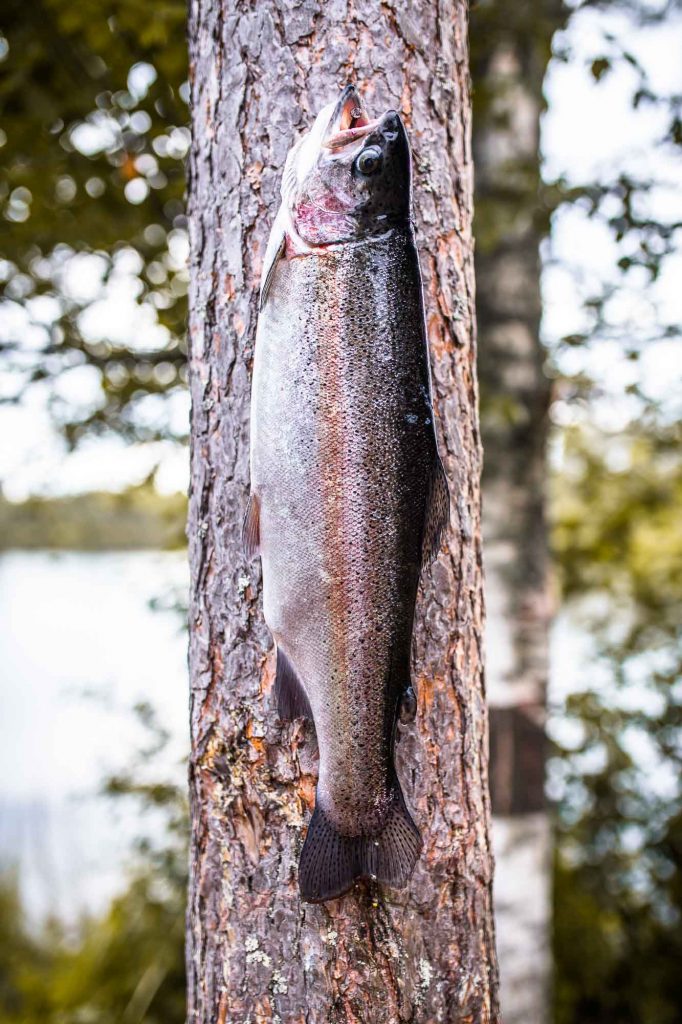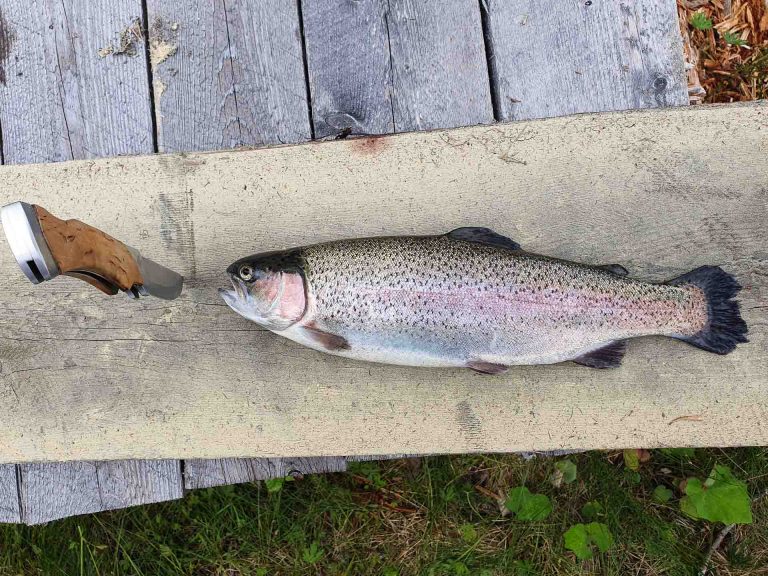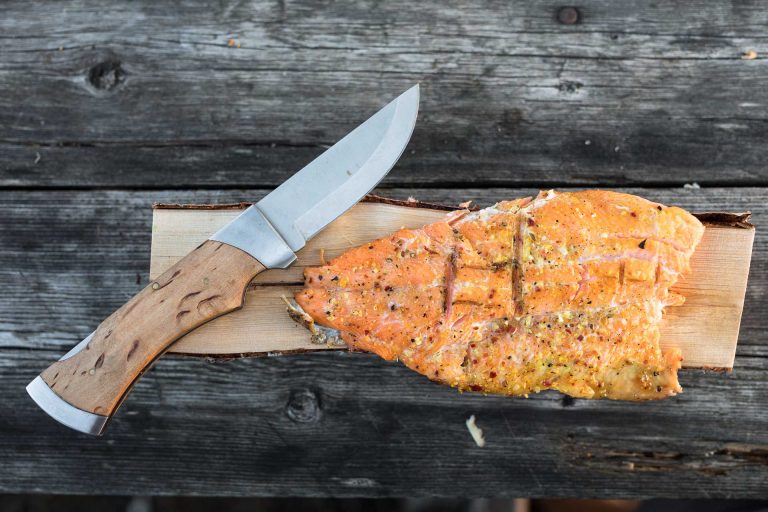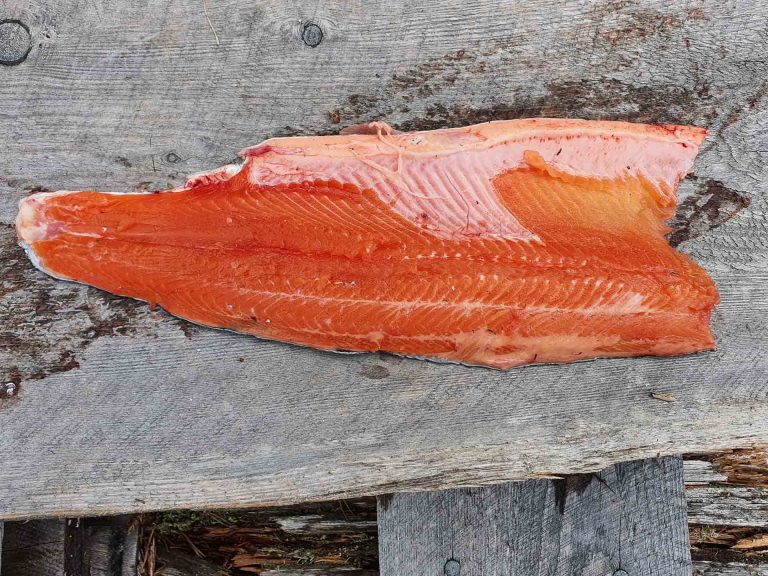Oncorhynchus mykiss (fin.: kirjolohi; swe.: regenbåge; nor.: regenbåge; dt.: Regenbogenforelle)

Rainbow trout (Oncorhynchus mykiss) is an other species of trout that can be caught in Scandinavia. However, this fish is not native to Finland, Sweden or Norway and always a cultivated fish stock. Especially in Finland and parts of Sweden there are many small lakes and rivers that offer great fishing possibilities to catch these fish.
Fishing and Fishing Methods
In rivers they are usually perused by using colourful lures (flies, spinner, spoon, wobbler…). In lakes they are usually fished with colourful artificial paste bait (locals refer to it as silicon). In Scandinavia it’s solely purpose is game for sport fishing. Some consider this as a very unnecessary introduction of a non native fish. However the fishing minds are divided on this as usual.

Spinning
- Wobbler small (0-10 cm)
- Wobbler between (11-20 cm)
- Spinners (0 – 5 grams)
- Spinners (6 to 12 grams)
- Spinners (over 12 grams)
- Spoons (big)
Fly Fishing
- Tub fly
- Dry Fly
- Nymphs
- Gold head Nymphs
- Stremers
- Wetflies
Angling
- Maggot (winter)
- Shrimp (often forbidden)
- Worm
- Live Fish (Ice Fishing)
- Dead Fish (Ice Fishing)
Trolling
- Wobbler small (0-10 cm)
- Wobbler between (11-20 cm)
Angling Record
- Finland: 10,42 kg
- Sweden: 14,16 kg
- Norway: N/A

Appeareance
The name rainbow trout refers to its wide pink-tinged stripe on its gill covers and sides, which also reflects other colors. You can also distinguish it from other salmonids from the side line and the dark-spotted dorsal and caudal fins. This fish has many different names among the locals and while sosome reffer to it even as ‚salmon’, ‚rainbow salmon’ or ‚trout salmon’.
Distribution and origin
The original home of rainbow trouts are the waters flowing into the Pacific Ocean in Asia and North America. In Asia, the species is found in Kamchatka and in places in the Ohotan Sea region and in the Americas from Alaska to the Sierra Nevada in the south. In this area, three ecological forms are distinguished from rainbow trout: a form that spends its entire life in streams, a form that lives in cold lakes, and a form that migrates to the. The inland water form in particular has been used for stocking. In Finland, the first rainbow trouts were imported from Germany in 1894 and planting in natural waters began in the early 20th century. Nowadays rainbow trouts have been planted in natural waters almost all over Finland and Sweden for recreational fishing purposes.
Increase
Rainbow trout breed in running waters and usually spawn in spring. In the Scandinavian wild, an increase in rainbow trout has been observed over the last years and in some places you can even talk about native rainbow trout stocks growing in the wild. Still, the vast majority of the fish are planted. Places, where conditions are suitable for spawning and embryo development, are still very rare throughout the North.
Feeding, growth and migration
Young rainbow trouts start their alomentation with zooplankton, followed by aquatic insects and their larvae and insects that have fallen to the surface of the water. In a later stage they feed on fish. Rainbow trouts planted in their juvenil stage in natural waters grow slightly better than trouts, but slower than salmon. Fish that are planted between arround 0.5-2.0 kg in rapids for example, do not usually grow much bigger in natural waters after planting. Rainbow trouts planted in running waters are often also obtained close to the planting site.
Fishing and catches
Rainbow trout are usually planted in catch sizes for sport fishing. These fish usually get caught pretty quickly and an estimated 1 million kg per year are caught by recreatinoal fishing.
Rainbow trout is also one of the most important food species farmed in Scandinavia with tens of millions of kilos produced every year. In Finland rainbow trout makes up arround 90 percent of the total food fish production. This is a huge business with hundreds of millions of Euros in play. Juvenil fish production takes place mainly in inland waters and the actual food fish production in the sea areas.
Stock threats, management and endangerment
Rainbow trout is an alien species that is said to compete in natural waters with native species, especially the native brown trout. However, there are no signs that rainbow trout have displaced any native species, even though there is a potential danger.

